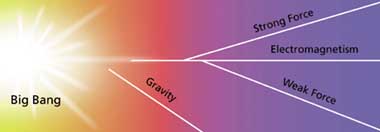electroweak theory

The four forces governing the interactions of matter and energy "condensed" from the unimaginable temperature and density of the Big Bang – gravity first, followed by the strong nuclear force and the electroweak force, which yielded the familiar electromagnetic force and the weak force that gives rise to radioactive decay. All but gravity can be linked by extensions of the Standard Model.
Electroweak theory is a relativistic quantum field theory that describes the weak force and the electromagnetic force in one unified framework. It followed the success of quantum electrodynamics (QED), which provided a quantum description of interactions between the electromagnetic field and particles of matter.
A lot of effort went especially into trying to describe the weak force with equations similar in form to those of quantum electrodynamics. This led to the prediction of a new set of exchange particles, called intermediate bosons, first detected in the 1970s, which would carry the weak force. In 1967, the American physicists Steven Weinberg and Sheldon Glashow and the Pakistani physicist Abdus Salam went one better by showing how the weak force and electromagnetism could be combined to give something called the electroweak interaction.
In today's universe, the weak force and electromagnetism are completely separate and distinct. But for the first trillionth of a second or so after the Big Bang, conditions were so extreme that the two forces were united. During that initial sliver of cosmic time, the temperature was sufficiently high that the weak force and electromagnetism were one and the same. Thereafter, the symmetry that had made them identical was broken or, rather, hidden, as when a pond of water, in which there's a high degree of internal symmetry, freezes to give ice in which the level of symmetry is less. Modern particle accelerators can reach energies comparable to those in the electroweak phase of the infant universe and have successfully tested theoretical predictions of this unified force.
Following the triumph of the electroweak synthesis, physicists were emboldened to try to corral the strong force with the electroweak in what became known as a grand unified theory, or GUT. See also string theory.


